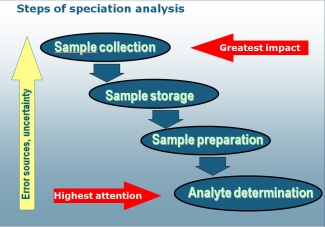Since techniques and methods for direct in-situ speciation analysis are very limited, samples have to be taken, brought to the laboratory and stored for later analysis. The preservation of the chemical integrity of the sample has to be the main objective of the storage strategy and is a major issue in speciation analysis.
In common with storage strategies for more simple trace element analysis this concern first of all the avoidance of loss and contamination of the analytes of interest. As a speciality for speciation analysis, any changes in species distribution or matrix properties relevant for speciation must be avoided. Unfortunately, species transformation may start already during sample collection.

While the analyst often pays a lot of attention on all error sources during the analysis in the laboratory, most often the biggest errors happen in the field during sampling (see the figure on the left side).
Since different species (e.g. valency species) are in equilibrium to each other and are related to the environmental conditions such as pH, redox conditions, total salt content etc., speciation might change when samples are isolated from those environments. Sample preservation must assure, that those species of interest do not change their distribution during sample storage. That means that the often applied preservation method for trace element analysis, namely acidification cannot be applied.
Since the environmental conditions should not change in a way influencing the species distribution, preservation should be done with minimum impact. A number of sources can be cited as causes of species instability:
- chemical reactions between species,
- interaction with the container material,
- microbial activity,
- changing chemical parameters (temperature, pH, pE)
- light action etc.
Therefore, it is very important to consider the influence of these factors on the species stability to get a representative analytical speciation of the studied sample. The selection of storage strategies for speciation analysis depends on the type of sample material, the storage time, the size and number of samples and the available resources. It usually also has to be designed with respect to the target species since generalizations or stability predictions can often not be done because of insufficient knowledge about the chemistry of the species in complex sample matrices.
As a rule of thumb the following recommendations can be given:
- Avoid sample storage whenever possible.
- Reduce sample storage duration to the absolute minimum.
- Reduce the contact area to container walls by using bigger sample volumes.
- Use clean container materials such as FEP.
- Store at reduced temperature <5°C (for short periods) or < -20°C.
- Store in the dark.
For further discussion, please consult more specific "Brief summaries" related to target species and sample matrices and the literature cited below.

Brief summary: Preservation strategies for arsenic speciation analysis (in preparation)

Brief summary: Preservation strategies for mercury speciation analysis (in preparation)

Brief summary: Preservation strategies for chromium speciation analysis (in preparation)
 Related literature:
Related literature:
 J.L. Gómez-Ariza
J.L. Gómez-Ariza, E. Moralez, I. Giráldez, D. Sánchez-Rodas,
Sample treatment and Storage in Speciation Analysis, in: L. Ebdon, L. Pitts, H. Crews, R. Cornelis, O.F.X. Donard, Ph. Quevauviller (eds.), Trace Element Speciation for Environment, Food and Health, RSC, Cambridge, 2001, 51-80.
doi: 10.1039/9781847552204-00051 J.L. Gómez-Ariza,
J.L. Gómez-Ariza, E. Morales, D. Sánchez-Rodas, I. Giráldez,
Stability of chemical species in environmental matrices, Trends Anal. Chem., 19/2+3 (2000) 200-209.
doi: 10.1016/S0165-9936(99)00192-2 Philippe Quevauviller,
Philippe Quevauviller, Maria Beatriz de la Calle-Guntinas, Eddie A. Maier,
Carmen Cámara,
A Survey on Stability of Chemical Species in Solution During Storage: the BCR Experience, Mikrochim. Acta 118 (1995) 131-141.
doi: 10.1007/BF01242236  Related EVISA Resources
Related EVISA Resources
 Link database: Sample preservation/Storage
Link database: Sample preservation/Storage Brief summary: Species transformation during speciation analysis
Brief summary: Species transformation during speciation analysis Brief summary: Speciation Analysis - Striving for Quality
Brief summary: Speciation Analysis - Striving for Quality  Brief summary: Error sources in speciation analysis - Overview
Brief summary: Error sources in speciation analysis - Overview Related EVISA News
Related EVISA News
 February 9, 2006: Preservation of arsenic speciation in natural water samples for up to three months
February 9, 2006: Preservation of arsenic speciation in natural water samples for up to three months
last time modified: June 10, 2024